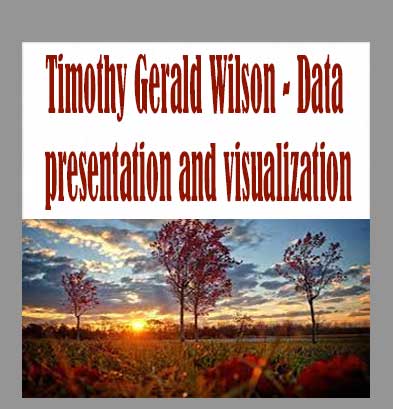Description
Timothy Gerald Wilson – Data presentation and visualization download , Timothy Gerald Wilson – Data presentation and visualization review , Timothy Gerald Wilson – Data presentation and visualization free
Timothy Gerald Wilson – Data presentation and visualization
Drive stakeholders to take action with the results of your reports and analyses
There is a dangerous belief that, because data is objective, it can speak for itself: as long as the charts and tables and slides are accurate, then the analyst’s work is done. This is analogous to stopping and going home after running 25 miles of a race and believing that you have completed a full marathon. What gets delivered in a report or as the result of an analysis, and HOW it gets delivered, is as critical in determining whether stakeholders take action with the information as the underlying analysis itself. More information is generally NOT better. Changing up the data visualizations throughout a presentation primarily just to “mix things up” is a terrible idea.
Presenting “the data” and expecting the stakeholders to draw their own conclusions is a guarantee that they will draw no conclusions at all! The great news is that there are a range of straightforward tips and techniques—grounded in some basic understanding of how the brain processes information—that can be learned and immediately put into practice to ensure that analytics deliverables are clear, understood, and retained by the business stakeholders to whom they are delivered.
Introduction video (4 minutes)
After taking this course you’ll…
- Identify the most effective data visualization for any situation so that the information is readily understandable by your target audience
- Create data visualizations that avoid pitfalls that can introduce confusion and require unnecessary effort for stakeholders to understand and internalize key takeaways
- Craft a narrative that holds the attention of key stakeholders, while also improving their ability to understand and retain the information being presented.
Skills you will master
Analysis and reporting Charts Data Presentation Data reports Data Visualization Sparklines
This course is essential for you if …
- You are responsible for analyzing data and presenting the results to peers, executives, or other stakeholders who need to make decisions based on the information you present to them.
- You want your analyses to be regarded as some of the most valuable work conducted within the organization.
- You need the skills necessary to improve the actionability of the reports and analyses you develop, as well as the ability to teach others how to develop those same skills.
This course is NOT for you if…
- Deeply believe that the “data speaks for itself,” so how that data is packaged and presented does not matter.
- Are already deeply familiar with and actively putting into practice the data visualization and data storytelling best practices established by Edward Tufte, Stephen Few, Dona M. Wong, Nancy Duarte, Cole Nussbaumer Knaflic, and Brent Dykes.
- You are extremely adept at doing the data crunching while relying on others to determine how best to take the results of that work and communicate it effectively so that the business can actually put it to use.
About the expert
Tim Wilson
Tim has been working with digital data full-time since 2001 in a variety of roles: from managing a web analytics platform migration and developing analytics processes as the head of the business intelligence department at a $500 million high tech B2B company; to creating and growing the analytics practices at multiple agencies that worked with a range of large consumer brands; to his current role consulting with the digital analytics teams at Fortune 500 companies on their strategies, processes, and tactics for effectively putting their sales, marketing, customer, and digital data to actionable use.
Your course curriculum
Data presentation and visualization
1 Communication overview
In this lesson, you will learn why data visualization, data storytelling, and effective communication are critical when it comes to effectively delivering analytics information, as well as some of the basics of how the brain works and why that matters. …
2 Overview: The brain science of communication
Three types of memory, Gestalt psychology, and examples of reducing cognitive load. Topics covered: There are three types of memory: iconic, short-term, and long-term.The limitations of short-term memory as illustrated by Miller’s Law, and why it is cr …
3 Overview: The Cognitive Load of Pie Charts
Among data visualization researchers and experts, pie (and doughnut) charts are universally reviled. In this lesson, we will explore why that is as an introduction to many of the concepts and ideas that are covered throughout the rest of this course. T …
4 Data Visualization: Maximizing the Data-Pixel Ratio
Maximizing the data-pixel ratio sounds like an entirely esoteric and theoretical concept, but it is arguably the single data visualization technique that, once practiced and mastered, will have the greatest impact on improving the effectiveness of your …
5 Data Visualization: Using Color Sparingly
As computer monitor technology has progressed, we are now at the point where most monitors can display 16.7 million different colors. But, just because you have an effectively infinite variety of colors available to use, doesn’t mean that you should! I …
6 Data Visualization: The Importance of the Axes
Axes may seem obvious and mundane, and most data visualization platforms automatically generate them. But, they can be generated poorly, and they can undermine the impact of a data visualization if they are not implemented effectively. Topics covered: …
7 Data Visualization: Horizontal Bar Charts for Comparing Categories
When it comes to visualizing categorical data, the horizontal bar chart is often the best choice. In this lesson, we will explore why that is, as well as how multiple horizontal bar charts can be used to provide a clear comparison of multiple metrics a …
8 Data Visualization: Line Charts for Visualizing Time-Series
Line charts are one of the most common types of chart, and they are especially good at showing how a metric has changed over time. In this lesson, we will explore the key considerations when it comes to developing a line chart. Topics covered: When lin …
9 Data Visualization: Sparklines and Small Multiples
While the default approach for data visualization is “a chart,” sometimes, using multiple charts together is a more effective way to convey information. That’s where sparklines and small multiples come in, which are the topic for this lesson. Topics co …
10 Data Visualization: Text as a visualization
Approach metrics written as text as visualizations in and of themselves. Topics covered: How standalone text can be a powerful visualization, and what goes in to ensuring that is the caseUsing text as the primary element in a data visualization in conc …
11 Data Visualization: Heatmaps
Heatmaps done well can be an incredibly effective way to represent a single metric across multiple dimensions in a way that enables the audience to quickly see which combinations of dimensions stand out. In this lesson, we will explore when heatmaps ar …
12 Data Visualization: Scatterplots
Correlation is not causation, but correlation—the positive, negative, or lack of a relationship between two metrics—can be key to making a specific point. In this lesson, we will explore how to use scatterplots to visualize the relationship between a p …
13 Data Visualization: Specialty Charts and Chart Elements
Waterfall charts, boxplots, error bars and more: when adding cognitive load is warranted. Topics covered: How non-standard chart types increase the cognitive load for the audience for the data visualizationWhy increasing the cognitive load can be okay, …
14 Data Visualization: Cautionary Charts and Bad Practices
Why 3D charts, stacked charts, bubble charts, and others are generally ill-advised Topics covered: How to assess a visualization to identify where it may be adding unnecessary cognitive load.How to experiment with alternate visualizations and assess th …
15 Data Visualization: Dashboard Considerations
There are two types of dashboards. Data visualization conceptscan be applied differently depending on the type. Topics covered: The difference between performance measurement dashboards and analytical interface dashboards.Key considerations when develo …
16 Data Visualization: Data Visualization Resources
A review of the key themes throughout these lessons, and resources for learning more Topics covered: A review of the main concepts and considerations for data visualization.Suggested resources for learning more.What we haven’t yet covered: data storyte …
17 Data Storytelling: The Power of Narrative
“Storytelling” is not a buzzword: information presented as narrative is more easily understood and more likely to be retained. Topics covered: What data storytelling is, and how “narrative” is at its core.The increase in engagement, retention, and reca …
18 Data Storytelling: Know Your Audience, Know Your Goal.
Who are you ultimately targeting, how will you reach them, and what do you expect them to do with the information you present? Topics covered: Key considerations once you identify your core audience.The importance of starting with a desired action.An u …
19 Data Storytelling: Establishing a Narrative (and a Flow)
Discovering the narrative before building out the content saves time and increases the ultimate impact. Topics covered: Why the way slide decks typically get produced lead to a meandering and ineffective finished product.How to develop the narrative fo …
20 Data Storytelling: McKinsey Titles and Reinforcing Content
The title of the slide is the most dominant position. Use it to maximum effect and then complement it with the content. Topics covered: What a McKinsey Title is and why it is more effective than a typical slide title.Why each slide in a presentation sh …
21 Data Storytelling: Data Visualization Tips Apply!
Decluttered slides and brain-friendly data visualizations make for high impact presentations. Topics covered: How maximizing the data-pixel ratio can be applied to slides.How the selective use of color can be used to maximum effect.The importance of in …
22 Data Storytelling: Kill the Bullets and Limit the Text
Bullets are bad, despite their proliferation in presentations. And they are unnecessary. Topics covered: Why bullets detract from the effectiveness of slides in a presentationHow to keep text to a minimum, while also selectively using color within text …
23 Data Storytelling: Presentations vs. Documents
Live presentations vs. the “leave-behind” version of the presentation vs. presentations never delivered live at all! Topics covered: What Slidedocs are (and how they differ from presentations). How to separate the “leave behind” from the “presented liv …
24 Data Storytelling: Compelling Imagery
A picture is worth at least 100 words, if not 1,000. Images are an easy and impactful way to support a data story. Topics covered: Why imagery is so effective when it comes to increasing engagement, comprehension, and retention.Tips for quickly finding …
25 Data Storytelling: Editing and Rehearsal
Thinking about what you will say for each slide is not rehearsal. Rehearsal is rehearsal, and it is a worthwhile investment of time. Topics covered: The importance of rehearsing a data story before delivering it.How rehearsal of a presentation is part …
26 Data Storytelling: Review and Resources for Learning More
A review of the key themes throughout these lessons, and resources for learning more. Topics covered: No data story is perfect. Don’t make that the goal.Every presentation of analysis is an opportunity to learn and improve.Resources for learning more. …
Frequently Asked Questions:
- Innovative Business Model:
- Embrace the reality of a genuine business! Our approach involves forming a group buy, where we collectively share the costs among members. Using these funds, we purchase sought-after courses from sale pages and make them accessible to individuals facing financial constraints. Despite potential reservations from the authors, our customers appreciate the affordability and accessibility we provide.
- The Legal Landscape: Yes and No:
- The legality of our operations falls into a gray area. While we lack explicit approval from the course authors for resale, there’s a technicality at play. When procuring the course, the author didn’t specify any restrictions on resale. This legal nuance presents both an opportunity for us and a boon for those seeking budget-friendly access.
- Quality Assurance: Unveiling the Real Deal:
- Delving into the heart of the matter – quality. Acquiring the course directly from the sale page ensures that all documents and materials are identical to those obtained through conventional means. However, our differentiator lies in going beyond personal study; we take an extra step by reselling. It’s important to note that we are not the official course providers, meaning certain premium services aren’t included in our package:
- No coaching calls or scheduled sessions with the author.
- No access to the author’s private Facebook group or web portal.
- No entry to the author’s exclusive membership forum.
- No direct email support from the author or their team.
We operate independently, aiming to bridge the affordability gap without the additional services offered by official course channels. Your understanding of our unique approach is greatly appreciated.
- Delving into the heart of the matter – quality. Acquiring the course directly from the sale page ensures that all documents and materials are identical to those obtained through conventional means. However, our differentiator lies in going beyond personal study; we take an extra step by reselling. It’s important to note that we are not the official course providers, meaning certain premium services aren’t included in our package:
Refund is acceptable:
- Firstly, item is not as explained
- Secondly, Item do not work the way it should.
- Thirdly, and most importantly, support extension can not be used.
Thank you for choosing us! We’re so happy that you feel comfortable enough with us to forward your business here.








Reviews
There are no reviews yet.